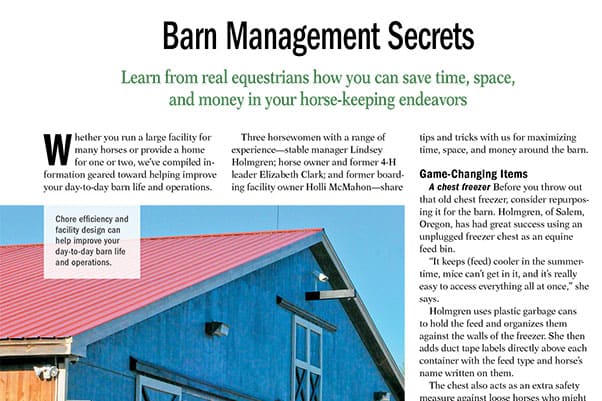
Horse Feed Storage and Preservation
Learn how to store hay and grain properly—keeping nutrients in and mold, rodents, and spoilage out.

Learn how to store hay and grain properly—keeping nutrients in and mold, rodents, and spoilage out.

Use winter downtime to declutter your horse barn and promote chore efficiency.

Stacking and tarping your hay correctly can ensure quality forage for your horse all winter.

Proper storage techniques help prevent spoilage, preserve nutrients, avoid mold, and protect against pests, helping your horse’s health and maximizing your investment.

Is your hay more than 6 months old? Then it might be losing vitamin A and E.

Learn how to keep horses and humans safe by storing your supplies and equipment properly.

A veterinarian gives tips for creating your own equine facility with horse health in mind.

Consider these horse health- and safety-oriented design aspects when building or renovating your barn.

Learn how to avoid combustion and barn fire caused by your stored hay.

Tractors, breeches, and horse-themed jewelry might make up your wish list. But what would your horse ask Santa for?

Whether you run a large facility for many horses or provide a home for one or two, we’ve compiled information geared toward helping improve your day-to-day barn life and operations.

Rats and mice spread disease and ruin horse feed. Learn how to reduce populations in your barn.

Opossums are the culprits that transmit the causative parasite of EPM to horses. Dr. Dan Howe of the University of Kentucky recommends making an effort to keep them out of the barn and away from the food and water supplies.

Buying hay and feed in bulk quantities can save money up front. Find out how long you can store hay, grains, and feed.

Your feed store is having a big sale, but here are some tips before you stock up.

Here’s how to react if your horse consumes feed designed for another animal.
Stay on top of the most recent Horse Health news with
"*" indicates required fields